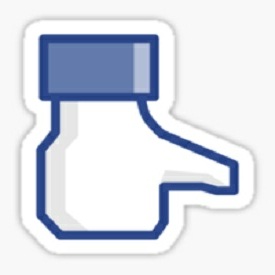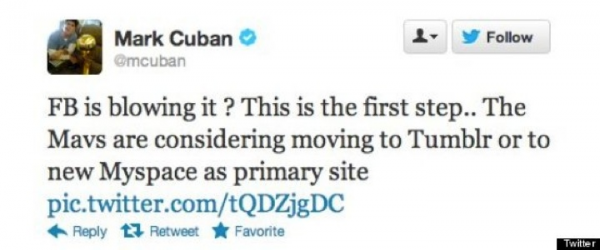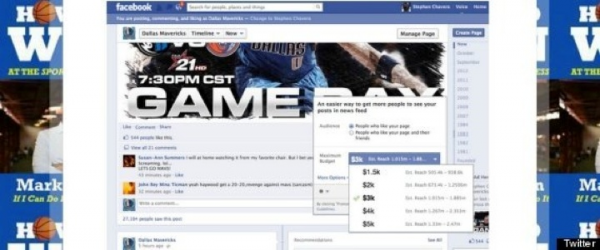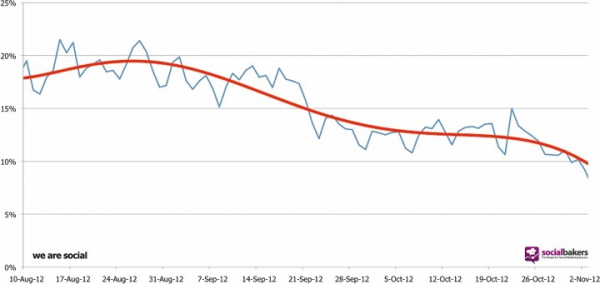Facebook recently introduced the ability for brands to increase reach for important posts and updates, but that reach comes at a cost. The prices varies depending on how many fans you have in your community. This new feature coincided with changes to the company’s Edgerank algorithm, which is how Facebook automagically filters posts in and out of your stream. Similar to how Google’s PageRank sorts results to better match your search intention, Facebook uses Edgerank to ensure that engagement is optimized and spam is minimized.
Following these events, many marketers and business executives have claimed a sharp decrease in unpaid post reach. Naturally, accusations of greed and corruption were hurled at Facebook as marketers believed that Facebook’s sole motive for this update was to force brands into a paid position to guarantee reach.
The controversy hit new heights when billionaire Dallas Mavericks owner Mark Cuban launched an offensive charging Facebook with a shakedown and thus threatening to move all of his community efforts to other social networks.
“FB is blowing it!” Cuban howled in a Tweet. He continued with a warning Facebook, one that he’s pursuing, “This is the first step. The Mavs are considering moving to Tumblr or the new Myspace as [sic] primary site.” He shared a telling screenshot in his Tweet of the Mavericks’s Facebook page showing a cost of $3,000 to reach one million of the team’s 2.3 million fans. If you do the math however, you’ll see the potential PPM of that equation is more than reasonable at $0.003 per person. Unfortunately, many experts missed this point.
The pile on continued though. We Are Social, a social media agency, and Socialbakers, developing of social network monitoring and tracking tools for analysis published findings that showed the average, organic post reach had dropped by 40% following the update to EdgeRank.
So, is overall organic post reach down?
Yes.
Is overall spam down as a result?
Yes.
Did Facebook purposefully change its EdgeRank algorithm to reduce reach and sell more ads?
Hardly.
If everyone reacted in similar fashion to Mark Cuban, not only would the business lose, fans lose as well. This is something I examined at length following GM’s famous pullout of its Facebook advertising budget earlier in 2012.
EdgeRank Explained
It’s important to understand how EdgeRank works before passing judgment or sparking fruitless debates. Whether you’re leading a paid, earned, or owned strategy, making informed decisions about goals and proper metrics starts with knowing the real challenges and opportunities.
In all honesty, Facebook should do a better job helping businesses understand not only EdgeRank, but how to better leverage the network as a whole in ways that are more meaningful for businesses and the community at large. But, we have to start somewhere.
In a post entitled, “News Feed, Engagement, and Promoted Posts: How They Work,” Facebook Ad Engineer Philip Zigoris aimed to bust myths while educating marketers. It tells the story of engagement and optimization:
Monitoring what types of posts are getting good responses is key, and always has been. Use Page Insights to determine what types of content – videos, posts, questions, etc. – are getting good engagement versus what types aren’t. Take a look at our Page Publishing Guide for posting best practices, and make sure to use our Page post targeting features so that you reach the audiences most likely to respond to your messages. And for posts that you see are getting a lot of responses, you can promote them to extend your reach to more news feeds.
What are the underlying EdgeRank factors that define whether or not someone sees a post in the news feed?
1) Facebook looks at whether or not you’ve previously interacted with an author’s posts or whether or not your friends are engaging around those posts.
2) If content is or isn’t engaged by your social graph and the network at large affects what you see and what you don’t see.
3) EdgeRank also examines whether or not your have interacted with similar types of posts in the past, i.e. photos, videos, polls, etc.
4) If content or page hosts have received complaints by other users, chances are that you will not see it.
Social Media Optimization is the New SEO
Engagement is the key to amplifying reach.
The debate unfortunately masks a much more important and productive discussion. Businesses confuse Facebook as a utility or service that’s there to help broadcast messages much in the same way businesses pay wire services to distribute press releases or brands buy advertisements on TV or radio to reach as many people as possible. Facebook is a social network to help people communicate, share, and discover. With over one billion people calling Facebook one of their digital homes, a social economy is a natural byproduct. Therefore, businesses must learn that relationships are earned and earned again and communities are built upon a foundation of mutual value, entertainment, and empowerment.
A like isn’t an opt in or subscription for marketing spam. It is an expression not a representation of a captive audience. Regardless of your community size, people are not idly waiting for your marketing messages. The reality is that only a small fraction of your overall community will see your posts. People may have Like’d you, but they’re also following friends, family, other brands and important organizations and events. With everyone publishing content, you’re competing for attention in real-time. Instead, consider competing for attention with the right content at the right-time.
Approach EdgeRank with a philosophy of contributing relevance to merit resonance. You can increase reach by optimizing posts, whether paid or organic, through social media optimization (SMO). If engagement drives reach, then design content to not just be consumable, but also shareable. Likes, comments, shares, tags, et al, spark a social effect and extend the life and volume of your updates. Simply publishing or paying for each without considering shareability or SMO is done so in vain.
This is true for any social network.
Whether you pay to play or you invest in organic engagement, the intention behind each strategy must be the same. Be relevant. Make it count. By striving for relevance, you will increase probability for resonance, which will over time contribute to your EdgeRank significance (RRS).
Originally published at AT&T’s Networking Exchange
Connect with me: Twitter | LinkedIn | Facebook | Google+
The End of Business as Usual is officially here…










Calmly refreshing post. Note to us business owners who flipped out about EdgeRank: Relax & focus on the big picture. Thank you!
Thank you Sherry!
I feel like everyone’s still talking about it but not many are changing their approach as a result. We need to move away from “like gates” and contests toward organic engagement.
“A like isn’t an opt in or subscription for marketing spam.” I wan’t to print this out and post it up somewhere for everyone to see.
Absolutely agreed. Print it. Plaster it. I’ll do the same!
It makes perfect sense for Facebook to continue to change and evolve its business services. Constant evolution is necessary for a successful businesses. Businesses need to learn how to adapt. Complaining does not solve anything. In my opinion, the EdgeRank changes are improving social media interaction for businesses. Businesses should focus on how to fully capitalize on the changes.
While I agree that social media is about content and community engagement, I do think Facebook is finding ways to make money. I have a small fan page and am part of a cooking community. My most popular and most seen post was one where I complained that not only were people not seeing my posts, I also was not seeing theirs. it reached beyond my fan base and everyone was frustrated. I preferred the Facebook feed I received before everything changed. I wish Facebook would let me decide what I want to see or at least let me prioritize my friends and Likes somehow.
Interesting thoughts…I always believed there should be a lever system that allowed us to fine tune our streams based on core elements until we got it the way we wanted.
Spot on as always Brian. I continue to have regular, soul-crushing discussions about this at my workplace. It’s always an overly complicated, uphill battle when it really is as simple as pausing for long enough to think like a consumer. And most of us are already on Facebook as consumers and have a wealth of insights to draw from our own engagement with brands. I mean honestly: When did a brand post last compel you to respond / engage? What was it about that post that made you act? How many brand posts did you actually even view this week?? Nobody wants to ask these common sense questions because they’re afraid of the answers. We’ve got to get truthful with ourselves and with our clients on what the value prop is for our fans. What is in it for THEM? Does/should anyone REALLY give a damn about our content? Why would I, as a consumer, want to be (and remain) a part of this community? Do we even know why we’re here to begin with?? Instead it’s about pointing fingers at the channels and worse, our own fans, for not falling over themselves to engage around our spam.
Tremendous thoughts. Thank you!
Hello Brian,
This is a great article (as always).
What bothers me the most about Facebook is not the fact that the company is asking people to pay for more reach. It really is the lack of transparency. I think FB could have announced things and offered monthly subscriptions, for example. Instead they chose to implement things behind the scenes.
“Whether you pay to play or you invest in organic engagement, the intention behind each strategy must be the same. Be relevant. Make it count. By striving for relevance, you will increase probability for resonance, which will over time contribute to your EdgeRank significance (RRS).” – Yes! It has always been about relevance and quality. You want your content to be relatable.
Thank you!
Thank you Cendrine…really appreciate you stopping by.
2 complicate….not all marketeers are engineers 🙁
it doesn’t hurt to step outside of our comfort zones every now and then. although, i lost my comfort zone long ago.
I like to think users are intelligent enough to know what they want to see and don’t want to see. It seems a little silly to have EdgeRank at all (or at least at the level it is now). If people no longer want to see content from your page, they’re free to hide updates from the page and only go to it when they want to see what you’ve been posting about…or to unlike the page altogether.
It should be similar to email. If someone opts in to your list (in the same way they opt in to become a fan of your page), it would seem a bit unreasonable for a service like Aweber or MailChimp to decide which people on your list do or do not receive your email based on some arbitrary, secret algorithm. At any time, people are free to set up a rule that sends your emails to their trash (akin to hiding Facebook updates from a page) or they can unsubscribe from the list (akin to unliking the Facebook page).
Why is there opposition to letting the user decide what they want to see?
You can still view your entire feed, it’s just not turned on by default. At the top of your feed, click on sort and then sort by most recent.
there you go!
Little known fact, even if you do that you will not be getting your entire feed. Facebook will still do some determining in the background for you.
yep. that’s what happens I think. We don’t see the entire feed even if you click on sort most recent.
Can you find something that confirms this? Can’t find anything in the Facebook docs and all I’m finding on Google are outdated posts.
Do you have a link to something that confirms this?
Nothing formal, but I have my feed set to “Most Recent” and I know, for me, I don’t receive all updates from pages I’ve liked. Hell, sometimes I don’t even get my own page’s updates in my feed.
I think it’s important that we don’t speculate and spread misinformation. According to Facebook, all it says is “Stories will appear in the order they were posted”. On my own feed this works fine and switching on Most Recent turns my feed into an unmanageable mess.
We don’t need to be hating on Facebook more than we already are so I just want to be sure it is not working before we tell others it does not work. I’m not saying you are wrong, but for my own selfish reasons I want to know exactly how the functionality works. Something I can direct clients to when they have questions.
Understandable. It should be fairly simple to test. Turn on “Most Recent,” then go through pages you’ve liked and try to match the timestamps between page updates and your feed. If updates are missing from your feed, then it would seem reasonable to assume EdgeRank is in play.
In my experiences, turning on Most Recent doesn’t negate EdgeRank in the sense that certain updates are still filtered out of your feed based on what EdgeRank determines is most relevant to you.
@MySocialGamePlan:disqus @JonBishop:disqus Another way to test this is to use the RockMelt web browser…it bypasses EdgeRank and gives you every update. I imagine HootSuite does this too, although I have never personally tested it.
Jon – I suppose you are not fan of many pages, are you? I like couple of hundreds of FB pages and I can tell FOR SURE you don’t see all posts even in “Most recent” mode. Actually, I only see a tiny fraction.
The Facebook News Feed I see when using Tweetdeck exposes all posts. The News Feed I see on Facebook exposes only a filtered list, even when selecting ‘most recent’.
Thank you for sharing!
This is very informative and helpful for us business owners. Thank you, Brian!
You’re welcome!
Brian, this is a really eloquent and effective post. The meta-point here is about social media, not just Facebook, as you point out. We need to plan on behalf of customers, not as advertisers, if we expect social media / online marketing success.
Thanks for pointing that out Wesley!
Fantastic Post thank you
I really don’t think it is realistic to expect getting exposure for free. Having said that, I would have believed changes in EdgeRank was to increase relevance; however, One of the most effective ways for me to reach my network was using the Questions feature, and I used to get great engagement and reach. Facebook took questions away for profiles, and removed the option to “Ask your friends” for pages. Now, Facebook wants me to pay to increase the reach of my questions. There was nothing wrong with the way it was setup and it would not show up on anyone’s stream unless they answered the question.
When Facebook introduced all the new ad products and it messed with Edgerank, I suggeted that we need to get better at writing better and more effective Ad copy, and creating better visuals for Facebook ads, because that is the only way to reach enough people with our message. I still believe that, and I don’t mind spending money on ads, especially with the figures you provided in your post.
It was a pleasure reading this and having the opportunity to share my thoughts.
Thank you for sharing your thoughts!
@snouraini:disqus you said:”for me to reach my network was using the Questions feature, and I used to get great engagement and reach. Facebook took questions away for profiles, and removed the option to “Ask your friends” for pages.” Yes it’s true, but I learned who in the past answered to questions and now I ask them – politely and by means of DM – to answer again to my new poll… and it works! Markets are nothing more than conversations, aren’t they? 😉
An idea worth a try, thank you!
I agree with you @snouraini:disqus the changes to the question app are the single most negative change FB has made!
It was an awesome way to poll and get valuable insight from my community. It removed friction and I’m trying to figure out a really good way to replace it.
Messaging would only increase another pet-peeve of mine – DM Spam
Awesome Post @briansolis:disqus ! I feel like it’s taking my own recent post to the next level by adding your insight and experience. http://tweet4ok.com/facebook-edgerank-can-be-a-chance/ Thanks for sharing!
Fantastic post Brian. I completely agree that businesses need to first understand Edgerank and then instead of trying to “beat” it, they need to learn how to manage it. At Marketo we are having great success turning FB into one of our top lead generating channels (actually number one for November) with two main strategies. One is to create an editorial calendar just as one would for a blog, but for Facebook. We then theme out the days and weeks around our overall content strategy, but change the messaging for FB by adding visuals (optimized for mobile) and a sense of humor. I have found that although marketers are not necessarily on FB to be sold to, if they are entertained by your post, they will often convert. The second is to use paid ads to supplement and promote your content to both highly targeted demographics and the highly coveted friends of friends. We post our actual metrics from these strategies to our blog as well. Bookmarking this post now as a resource, and will be sure to share with our community.
Jason Miller – Marketo
Hi Brian,
I have mixed emotions, but the real truth is, I have never really felt safe or comfortable in FaceBook’s environment. I understand the need to generate revenue, but the trust level is far too low for this old man.
I’m not suggesting any of the social networks are safe, they all have their weaknesses and strengths, FaceBook tends to behave like the neighborhood bully, and I don’t like bully’s. But that’s just my perspective : )
Love your work, you are one of ten people that get my attention everyday. Thanks for all you do.
Cheers Owen!
HI Brian,
First let me say you’ve had a tremendous impact on my career going back several years. So it goes without saying I have a high respect for you. But I disagree completely with your post. I manage over 20 Facebook pages and many of these I have managed for more than two years, before all of the changes started taking place. I can unequivocally say that the exposure of posts significantly decreased at almost the exact same time they started doing promoted posts and around the same time they went public – including on pages that have robust communities and regularly get high engagement. I have attached a picture that supports what I am saying. This post had 857 likes, 39 comments and 213 shares. Yet out of 25k fans only 4500 saw it outside of the paid post??? Ok, so let’s pretend this was a special situation and other than this post, the page never gets any engagement and thus has low edgerank (which is totally not the case, this is truly an engaged “community”), then at a minimum Facebook has redefined what it means to “share”. As you can see in the picture, this was shared 213 times but only got 310 viral views – this is absolutely ridiculous.
I think it is a totally separate conversation about whether businesses should have to pay to publish on Facebook. But for the question is Facebook purposely reducing exposure to force companies to pay, yes. Edgerank matters extremely little (if at all anymore) when comparing to paying for posts.
Sorry, forgot to attach the image for my comment below. Here it is.
First let me say you’ve had a tremendous impact on my career going back several years. So it goes without saying I have a high respect for you. But I disagree completely with your post. I manage over 20 Facebook pages and many of these I have managed for more than two years, before all of the changes started taking place. I can unequivocally say that the exposure of posts significantly decreased at almost the exact same time they started doing promoted posts and around the same time they went public – including on pages that have robust communities and regularly get high engagement. I have attached a picture that supports what I am saying. This post had 857 likes, 39 comments and 213 shares. Yet out of 25k fans only 4500 saw it outside of the paid post??? Ok, so let’s pretend this was a special situation and other than this post, the page never gets any engagement and thus has low edgerank (which is totally not the case, this is truly an engaged “community”), then at a minimum Facebook has redefined what it means to “share”. As you can see in the picture, this was shared 213 times but only got 310 viral views!!!
I think it is a totally separate conversation about whether businesses should have to pay to
publish on Facebook. But for the question is Facebook purposely reducing exposure to force companies to pay, yes. Edgerank matters extremely little (if at all anymore) when comparing to paying for posts.
I am going to mostly agree, in a sense, with @jg, @Jonathan Payne. Thing is, I know plenty of people that view their feed, but don’t necessarily Like or Comment any posts, especially ones of Pages. And yet, they still want to see those Pages, they still got value out of those Pages in the past. For me even, there’s Pages I simply don’t see anymore, that I wish I did, for which I have Interest lists, or the Pages Feed. Nonetheless, EdgeRank isn’t perfect in that sense. If a Page spams me endlessly, or I don’t Like it, then I will stop following it. It wasn’t necessarily up to Facebook to decide that for me via EdgeRank.
Brian, great post. You know I’m a big, and long time fan. To that end, I’m struck by the fact that, I consider you one of the most diplomatic (recovering) PR pros in the industry and yet this post strikes a tone I’ve never read in your work. Clearly there’s passion. But lets drop the marketing debate for a moment, and look at it from a user’s perspective: I’m a user. I like a brand. I do that because I want to see their content. I don’t want Facebook deciding what it thinks I should or should not see. I’ve read Scoble’s argument on this, I’d imagine, based on the content here, your view is similar, but I think so many of us feel that way. I can filter out my own brands. And that, I think, is also relevant to the marketers building communities.
Thanks for a great post! Your point about SMO and shareability resonated with me the most. As an active Facebook user and marketing student, I subscribe to dozens of pages that I barely pay attention to, whether they make their way into my newsfeed or not. In such a noisy space, it doesn’t matter if a brand finds its way in front of an audience by paid or organic methods. Brands have to say something relevant to spark their audience’s attention and prompt sharing. I also agree with you that Facebook and other social networks should do a better job of explaining EdgeRank et al. to help businesses create a more meaningful community. I will be interested to see how EdgeRank and other Facebook features continue to evolve in response to businesses and users.
I know that EdgeRank cannot be estimated. But keep in mind that each FB page has its own PR which I prefer as criteria for my FB pages.
Post privacy gating (or page post targeting, as Zigoris calls it even though Facebook doesn’t use that term) is a phenomenal feature that few community managers take advantage of.
I think the biggest mistake you can make on Facebook is shamelessly begging for likes or comments, and not intelligently scaling your posts to the individual persona’s represented within your Facebook fans. Which is crazy considering the insights that are available to the page owner about their fans!
Here’s a couple ways I take advantage of the post privacy gating feature, and a case study on how it works: http://www.outspective.com/social-media/how-to-improve-facebook-edgerank-using-this-hidden-feature/
very informative post. Thanks !
You’re welcome…
Wow Very nice and informative post about Social Media SEO. Increased my knowledge!. I would like to say “Thank you so much for this excellent sharing”.
Facebook is integrating changes every so often that sometimes, it can be difficult to keep up. I’ve read the comments and there were some complaining about the news feed – how they can’t see all the posts and all that. I have been into SEO for a while now but I’ve just recently started with Social Media marketing. I’ve been having similar problems as well. That is, I can’t seem to see all the post.
Its weird though that something that has worked for a long time, and recently just a month ago, has almost decreased with 50% for no reason? An average of 500/900 likes down to 100-200 likes in only one month or so? trying to find answers…
very positive post
Thank you…
Thanks for the information.. nice post..
Hi, you explained the topic very well. The contents has provided meaningful information thanks for sharing info